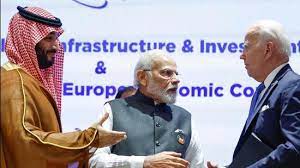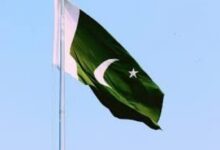Middle East, Asia, and Europe Economic Corridor Directly Competes With China’s BRI and Has the Potential to Revolutionize International Trade
Leaders of India, Saudi Arabia, the United Arab Emirates, France, Germany, Italy, the United States, and the European Union (EU) have announced a memorandum of understanding (MOU) on a new India-Middle East-Europe Economic Corridor (IMEC) to unlock the economic potential of the region, taking a page from President Xi Jinping’s book on connectivity.
If IMEC succeeds, both continents will get a tremendous boost. However, this is currently just on paper, and it will take at least ten years to get it up and running, assuming that all nations stay on board. The initiative cannot be protected against political headwinds, such as elections, government changes, and unanticipated circumstances that might drive away many of the current signatory nations.
A special event about the India-Middle East-Europe Economic Corridor (IMEC) and the Partnership for Global Infrastructure and Investment (PGII) will be held on September 9, 2023, concurrent with the G20 Summit in New Delhi.The purpose of the event was to increase funding for infrastructure development and improve connection between India, the Middle East, and Europe in all of its forms. The IMEC consists of a Northern Corridor linking the Gulf to Europe and an Eastern Corridor linking India to the Gulf area. It will also include roads for transportation as well as a network for ship-rail travel.
The US statement, which refers to the project as a mega-project, goes on to say that “this landmark corridor is expected to stimulate economic development through enhanced connectivity and economic integration across two continents, thus unlocking sustainable and inclusive economic growth.”
The pact will link India to nations in the Middle East, then to Eastern and Western Europe, through ports, shipping lanes, and rail lines.
Analysts including US Vice President Joe Biden have already hailed the suggestion as a game-changer, but there are always slips between the cup and the lip, as the phrase goes.
“Two things strike me about this initiative: first, the suggested scale of investment is an indication of how seriously the Saudis and UAE take India and India’s economic potential,” says Prof. Ian Hall of Griffith University in Brisbane, an authority on international relations. “However, other from providing an alternative to BRI projects, the infrastructure’s function is still unclear. Energy is likely not the major focus since it is costly to transport oil and gas across land. Then, does it have to do with Indian exports to the Middle East? Of what, then? Perhaps food or products made by humans, like vehicles. We don’t currently have enough information to assess it.
A large portion of this connectivity push is intended to restrain China’s Belt and Road Initiative (BRI), the grandiose initiative that Xi originally floated in 2013. The project, which was mostly supported by China’s state-owned banks, has the support of countries in Central Asia, South Asia, the Middle East, and numerous African countries. However, due to their inability to repay, several of the nations, including Sri Lanka, have fallen into a debt trap. Some African nations had the same situation.
Due to the China-Pakistan Economic Corridor’s (CPEC) passage through Pakistan invaded Kashmir (POK), which India views as its own region that Pakistan has unjustly invaded, India has repeatedly opposed the BRI and refuses to participate in it. Italy, a significant BRI signatory, recently withdrew from the agreement.
The expansion of the Gwadar port in Pakistan and the railway network in the troubled Balochistan area are the BRI’s focal points. The 2000 km long road and rail network, which includes Kashgar in the autonomous province of West China, links the port city to the CPEC. The agreement was meant to revolutionize everything and turn the mineral-rich but undeveloped area into a bustling economic centre. Although a lot of it has less to do with the CPEC and more to do with domestic unrest in Balochistan, the region is not flourishing.
Perhaps the specifics of the economic corridor have not yet been worked out or discussed in public. Also unknown is the funding.
Although most experts believe it is too early to make any judgments, the IMEC is a great concept and has the potential to drastically change the economies of the nations it would travel through.
According to former Indian ambassador Gurjit Singh, “various ambitious announcements like the EU Global Gateway, US Build Back Better, and India-EU connectivity now have a peg to hang on with this futuristic and visionary idea.”
Although everyone is in agreement that the signing of the MOU by IMEC has great potential, numerous elements will ultimately determine how it turns out. To learn more, one might just wait and observe for the time being.
“This will benefit India, the Gulf, and Europe if it is financed and put into practice. When Biden visited Saudi Arabia in July 2022, they spoke about this. The Saudis agreed to participate in this endeavor but refused to normalize ties with Israel. If it works out, Indians, particularly those with technical skills, may have greater employment prospects in the GCC, where certain nations, like Kuwait, are attempting to minimize the number of foreigners, according to former Indian ambassador KP Fabian.







